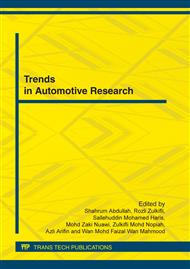p.130
p.135
p.140
p.145
p.150
p.155
p.160
p.165
p.170
Underhood Fluid Flow and Thermal Analysis for Passenger Vehicle
Abstract:
The present paper reports a simulation study of the fluid flow and thermal phenomena in the passenger vehicle underhood compartment by analysing velocity magnitude, temperature, radiator heat transfer rate and heat transfer efficiency. Analyses are carried out on a half cut passenger vehicle sample model by using commercial computational fluid dynamics (CFD) software, Star CCM+. Total volume meshes of the model are 24 451 759 cells, and the speed of the car is 0.036, 40, 70, 110, 130 and 213 km/h. Investigation are performed for three dimensional conditions, steady state gas with segregated flow, constant density, turbulence flow, with the use of the Reynolds-Averaged Navier-Stokes model and the K-Epsilon turbulence model. In the thermal analysis, particular attention is given to find hot spot locations under the hood. . High temperature region is observed at the right side of the hood (from the top of view) due primary heat sources from the engine. An air intake at hood is introduced in order to facilitate the airflow to engine room and to remove hot spot to the atmosphere. It is shown that the underhood average temperature decreases by 26.2% and the average airflow velocity at section plane of the centreline increases by 14.5% by adding this air intake.
Info:
Periodical:
Pages:
150-154
Citation:
Online since:
April 2012
Price:
Сopyright:
© 2012 Trans Tech Publications Ltd. All Rights Reserved
Share:
Citation:


